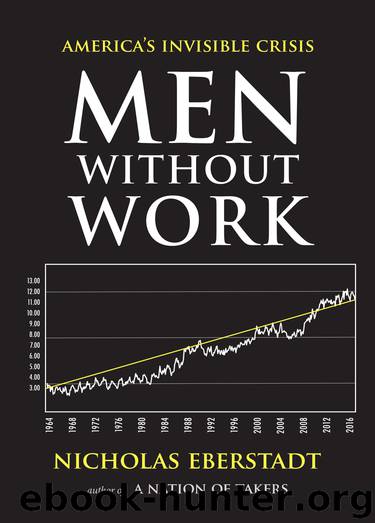Men Without Work by Nicholas Eberstadt

Author:Nicholas Eberstadt
Language: eng
Format: epub
Publisher: Templeton Press
Means-tested benefits, of course, are not the only variety of government assistance that un-working men rely upon. Disability benefits—temporary or permanent pensions for those officially declared incapable of working to support themselves—are a major source of income for prime-age men who neither have a job nor are looking for one. By all indications, disability payments are an increasingly important source of support for such men.
Unfortunately, considerable uncertainty and even confusion exists about the true extent of NILF dependence upon U.S. disability programs. No central authority keeps track of America’s many separate disability programs. The main program is Social Security Disability Insurance (SSDI). It dispensed more than $11 billion a month to over ten million beneficiaries as of late 2014.3 There is also the Supplemental Security Insurance (SSI) program, which provided an additional $4.4 billion a month in late 2014 to some eight million claimants.4 The Veterans Administration disability compensation program paid out another $4.5 billion a month to 3.5 million beneficiaries as of 2013.5 On top of these and other less-familiar or well-tracked disability programs, there are also workers’ compensation benefits at the state level.6 The United States is currently spending hundreds of billions of dollars a year on disability payments and the bureaucracies that administer them. Yet we do not know exactly how much money is being devoted to such claims or how many people in America are receiving payouts from one or more of these programs.
Suffice it to say that researchers will seriously underestimate the scope and scale of disability payments in America today if they focus on SSDI alone. This, however, is exactly what the president’s CEA seems to have done in its recent report on declining LFPRs for prime-age men in America:
SSDI receipt rates have been rising among prime-age men for the last 50 years. Today, 3.3 percent of prime-age men receive SSDI payments. A number of research papers find that increases in the number of people receiving SSDI led to lower labor force participation among the general population . . . and to lower earnings . . . However, from 1967 until 2014, the percentage of prime-age men receiving disability insurance rose from 1 percent to 3 percent, not nearly enough to explain the 7.5-percentage-point decline in the labor force participation rate over that period . . . So while SSDI receipt’s impact on prime-age male labor force participation is negative, under reasonable assumptions it is small and cannot explain more than a portion of the overall decline in participation.7
The CEA’s conclusion hinges on the assumption that SSDI is the only source of disability support available to un-workers today. But a more comprehensive assessment would recognize that un-workers can access disability funds from a multiplicity of programs that currently exist and that disability payments, like other of income sources, are fungible, meaning men can live on disability checks sent to others in their household.
Table 8.2 presents 2013 and 1985 SIPP data on disability program income for prime-age men, according to employment status. Over these three decades, the share of prime-age men reporting disability payments rose from 4.
Download
This site does not store any files on its server. We only index and link to content provided by other sites. Please contact the content providers to delete copyright contents if any and email us, we'll remove relevant links or contents immediately.
International Integration of the Brazilian Economy by Elias C. Grivoyannis(72848)
The Radium Girls by Kate Moore(11594)
Turbulence by E. J. Noyes(7682)
Nudge - Improving Decisions about Health, Wealth, and Happiness by Thaler Sunstein(7220)
The Black Swan by Nassim Nicholas Taleb(6745)
Rich Dad Poor Dad by Robert T. Kiyosaki(6158)
Pioneering Portfolio Management by David F. Swensen(6057)
Man-made Catastrophes and Risk Information Concealment by Dmitry Chernov & Didier Sornette(5630)
Zero to One by Peter Thiel(5470)
Secrecy World by Jake Bernstein(4370)
Millionaire: The Philanderer, Gambler, and Duelist Who Invented Modern Finance by Janet Gleeson(4071)
The Age of Surveillance Capitalism by Shoshana Zuboff(3968)
Skin in the Game by Nassim Nicholas Taleb(3957)
The Money Culture by Michael Lewis(3822)
Bullshit Jobs by David Graeber(3809)
Skin in the Game: Hidden Asymmetries in Daily Life by Nassim Nicholas Taleb(3714)
The Dhandho Investor by Mohnish Pabrai(3548)
The Wisdom of Finance by Mihir Desai(3513)
Blockchain Basics by Daniel Drescher(3314)
